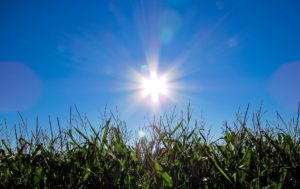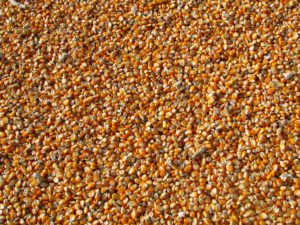 Corn
Corn
Watch the video to see a corn harvest, and read more to learn about the different types of corn, corn products, and other cool corn facts!
First, did you know that corn and maize are the same thing!
Second, did you know that corn is in pop, soup, fireworks, and biodegradable diapers!
Science Kids (2016)1 shared the following:
- “With the exception of Antarctica, corn is produced on every continent in the world.
- As well as being eaten by the cob, corn is also processed and used as a major component in many food items like cereals, peanut butter, potato chips, soups, marshmallows, ice cream, baby food, cooking oil, margarine, mayonnaise, salad dressing, and chewing gum.
- Juices and soft drinks like Coca-Cola and Pepsi contain corn sweeteners. A bushel of corn can sweeten 400 cans of soft drink.
- Corn and its by products are also found in many non-food items such as fireworks, rust preventatives, glue, paint, dyes, laundry detergent, soap, aspirin, antibiotics, paint, shoe polish, ink, cosmetics, the manufacturing of photographic film, and in the production of plastics.

- Corn is also used as feeding fodder for livestock and poultry and found in domestic pet food.
- As of 2012, the United States produces 40% of the world’s total harvest making it the biggest maize producer in the world (273,832,130 tonnes produced in 2012).
- An area termed the “Corn Belt” in the US where growing conditions are ideal includes the states of Iowa, Illinois, Nebraska, Minnesota, Indiana, Ohio, Wisconsin, South Dakota, Michigan, Missouri, Kansas and Kentucky.
- In the days of the early settlers to North America corn was so valuable that it was used as money and traded for other products such as meat and furs”.
Sweet Corn vs Field Corn:
Iowa Corn Promotion Board and Iowa Corn Growers Association (2017)2 explain the difference as follows:
- “Only one percent of corn planted in the United States is sweet corn.
- 99 percent of corn grown in Iowa is “Field Corn”. When Iowa’s corn farmers deliver corn from the field, it’s “Field Corn”. Not the delicious sweet corn you might enjoy on the cob or in a can.
- Field corn is the classic big ears of yellow dented corn you see dried a
 nd harvested in the fall. It’s called “dent corn” because of the distinctive dent that forms on the kernel as the corn dries.
nd harvested in the fall. It’s called “dent corn” because of the distinctive dent that forms on the kernel as the corn dries. - While a small portion of “Field Corn” is processed for use as corn cereal, corn starch, corn oil and corn syrup for human consumption, it is primarily used for livestock feed, ethanol production and manufactured goods. It’s considered a grain.
- Sweet corn is what people purchase fresh, frozen or canned for eating. It’s consumed as a vegetable. Unlike “Field Corn”, which is harvested when the kernels are dry and fully mature, sweet corn is picked when immature”.
Corn Product:
There are over 3,500 different uses for corn1.
Here is one example of what 1 acre of corn could potentially produce and a few benefits for using this crop:
- Corn Bread – 34,545 loaves
Assumption: One acre is roughly the size of a football field without the goal posts. 170 bushels per acre3 and 1 bushel is 56 lbs; thus, 9,520 lbs (4,318,199 grams). 1 loaf uses 125 g of cornmeal4
Farm Equipment:
Interested in seeing equipment used to harvest corn, check out this blog: http://thefarmerslife.com/farmers-harvest-corn/
Sources:
1 http://www.sciencekids.co.nz/sciencefacts/food/corn.html
2 Iowa Corn Promotion Board and Iowa Corn Growers Association (2017). Corn Facts. https://www.iowacorn.org/media-page/corn-facts/
3 http://www.cornandsoybeandigest.com/blog/usda-crop-predictions-sends-corn-and-soybean-prices-lower-july-estimates
4 https://www.ocado.com/webshop/recipeView.do?recipeId=3684&dnr=y
Images courtesy of: https://pixabay.com/en/photos/?image_type=&cat=&min_width=&min_height=&q=corn&order=popular


